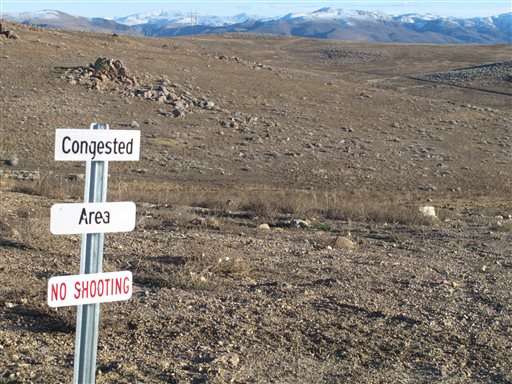Suit: US grouse protections driven by politics, not science

Rural Nevadans suing to block the Obama administration's greater sage grouse protection plan say a trail of internal government documents shows politics drove a pre-determined policy that conflicts with scientific findings.
The federal court motion seeks to void the protections that have restricted the development of millions of acres of federal land across the West. In some cases, the protections have made sections of federal land off limits.
Nevada Attorney General Adam Laxalt and lawyers for nine Nevada counties, ranchers and miners say three top Interior Department officials who dubbed themselves the "Grouseketeers" illegally sought opinions from conservationists outside the planning process.
The motion for summary judgment filed in Reno last week also says the U.S. Bureau of Land Management ignored its staff's advice to do more scientific study and "reverse-engineered studies with pre-determined conclusions designed to defend the land management restrictions."
"There was a political agenda rather than a scientific basis for requiring withdrawals and absolute prohibitions on development and use," Reno attorney Laura Granier wrote on behalf of the plaintiffs, who first sued in September to block sage grouse protections.
They argue the public has been "unlawfully deprived of the disclosure and impact analysis required" under federal law. They've asked Judge Miranda Du—twice before, unsuccessfully—to suspend the protections until the government conducts another study to analyze changes made to the protection plans after they were submitted to the public.
Administration officials did not immediately respond to requests for comment. They have said agency officials do not comment on pending litigation. Judge Du gave the government until April 25 to respond.
Interior Secretary Sally Jewell decided in September that Endangered Species Act protections were not needed for the chicken-sized bird that inhabits sage brush ecosystems across 11 Western states. North America's greater sage grouse population, once estimated at 16 million, is down to 200,000 to 500,000 birds because of lost habitat.
Officials want to withdraw 10 million acres of land from future mining claims, prohibit oil and gas drilling near the bird's breeding grounds and impose new reviews on livestock grazing permits to avoid the need for more severe restrictions endangered species protection would bring.
Environmentalists argue Jewell had no basis to reverse her department's earlier finding in 2010 that listing the bird was warranted but precluded. They recently filed their own lawsuits saying the land-use rules don't offer enough protection.
The ranchers, miners and Nevada counties say the Fish and Wildlife Service, Forest Service and the Bureau of Land Management rushed through the process because they considered meeting a deadline for a listing decision more important than complying with the law.
"The administrative record reveals astonishing overreach and disregard for public involvement and statutory requirements to impose a top-down policy engineered by three officials in the Department of Interior," Granier wrote.
She identified the three "Grouseketeers"—a phrase apparently based on the "Mousketeers" of "The Mickey Mouse Club"—as Deputy Assistant Interior Secretaries Jim Lyons and Michael Bean, and Sarah Greenberger, legal counsel to Jewell. She said the trio met after the public comment period with environmental leaders to "get insight as to what would be required for (them) to 'buy-in'''on the plans.
Laxalt said the protections halt development on nearly 3 million acres "that Nevadans depend on for their economic livelihood."
Opponents contend the rules prevent construction of a $500 million wind project and could "run ranchers and mining companies out of business."
Laxalt said federal law requires the government to consider concerns raised by the state and its citizens "not just special interest environmental groups."
The motion says the Fish and Wildlife Service drew boundaries around what became priority grouse habitat areas based on maps and information from the "conservation community" and then BLM unlawfully ignored the Nevada Wildlife Department that demonstrated the boundaries were inconsistent with the state's data and actual science.
It says the government prepared "form responses" to Nevada Gov. Brian Sandoval's objections "before even receiving them, and cookie-cutter responses to the public and county protests, which are identical in form regardless of the issues raised."
© 2016 The Associated Press. All rights reserved.
















